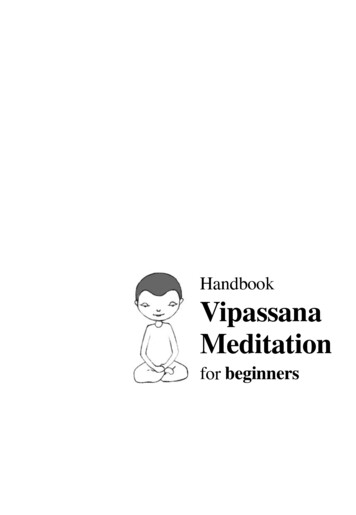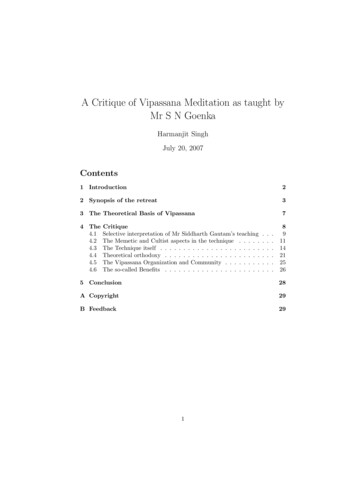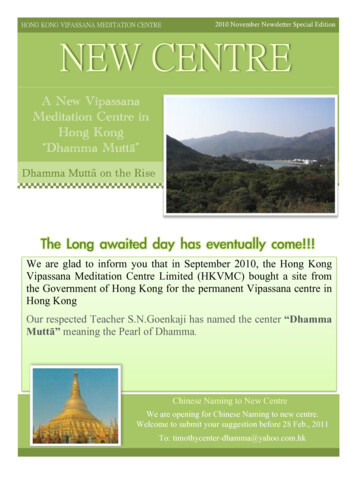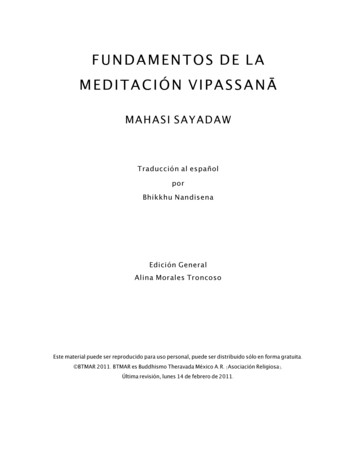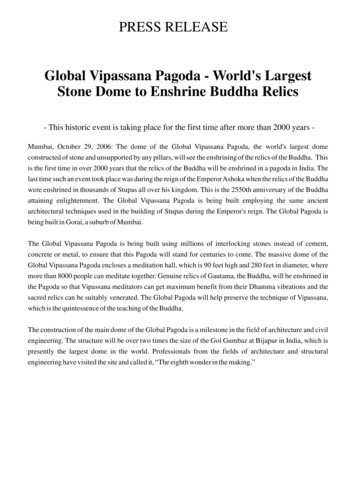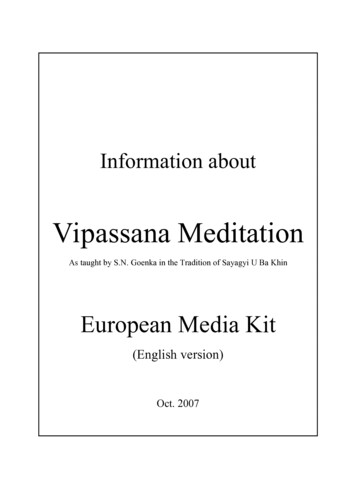
Transcription
Information aboutVipassana MeditationAs taught by S.N. Goenka in the Tradition of Sayagyi U Ba KhinEuropean Media Kit(English version)Oct. 2007
Vipassana MeditationAs taught by S.N. Goenka in the tradition of Sayagyi U Ba KhinTable of Contents1. INTRODUCTION . 21.1. INTRODUCTION TO VIPASSANA MEDITATIONa) Vipassana Meditationb) Historical Backgroundc) Ten-day Coursesd) A Universal Techniquee) Course Finances1.2. WHAT IS VIPASSANA MEDITATION AND WHAT IS IT NOT?2. MEDITATION TECHNIQUE. 42.1. TEN DAYS OF SILENCE & ETHICAL PRINCIPLES2.2. THE MEDITATION TECHNIQUE2.3. DAILY TIMETABLE ON A VIPASSANA COURSE3. S.N. GOENKA. 63.1. FROM BUSINESSMAN TO SPIRITUAL TEACHER3.2. POET AND SPEAKER AT DISTINGUISHED FORUMS3.3. COMMITMENT TO PEACE4. THE SPREAD OF VIPASSANA . 84.1. VIPASSANA ACROSS EUROPE4.2. COURSE SCHEDULES5. ORGANISATION . 95.1. IN GENERAL5.2. VOLUNTEER WORK5.3. FINANCES6. VIPASSANA AND SOCIAL CHANGE. 106.3.6.4.6.5.6.6.VIPASSANA IN PRISONSVIPASSANA AND DRUG REHABILITATIONVIPASSANA IN TRAINING AND BUSINESS ADMINISTRATIONCONCLUSION7. MORE INFORMATION . 127.1.7.2.7.3.7.4.7.5.INTERNET LINKSPHOTOSLITERATUREDOCUMENTARY FILMSREFERENCES, ARTICLES8. CONTACT . 14EU Media Kit: Vipassana MeditationOct. 2007page 1
Vipassana MeditationAs taught by S.N. Goenka in the tradition of Sayagyi U Ba Khin1.INTRODUCTION1.1. Introduction to Vipassanaa)Vipassana MeditationThe technique of Vipassana meditation is a simple, practical way to achieve real peace of mindand to lead a happy, useful life. Vipassana means "to see things as they really are" and thetechnique is a logical process of mental purification through self-observation.From time to time, we all experience agitation, frustration and disharmony. When we suffer, wedo not keep our misery limited to ourselves; instead, we keep distributing it to others. Certainlythis is not a proper way to live. We all wish to live at peace within ourselves, and with thosearound us. After all, human beings are social beings: we have to live and interact with others.How, then, can we live peacefully? How can we remain harmonious ourselves, and maintainpeace and harmony around us?Vipassana teaches us to observe the reality within ourselves. Through this impartial observationwe gain insight into the causes of our agitation or dissatisfaction. Out of ignorance we keepreacting in a way which is harmful to ourselves and to others. But when wisdom arises and onecomes out of this habit of blind reaction one is capable of real action - action proceeding with abalanced, equanimous mind, a mind which sees and understands the truth.In this way, Vipassana meditation helps us to dissolve the tensions and unravel the knots withinand lead a more positive, balanced and happy life - full of peace, harmony and goodwill forothers.b)Historical BackgroundVipassana is one of the most ancient meditation techniques. It was discovered in India 2.500years ago by Gotama the Buddha and is the essence of what he practised and taught during hisforty-five years of teaching. During the Buddha’s time, large numbers of people in India werefreed from the bonds of suffering by practising Vipassana, allowing them to attain high levels ofachievement in all spheres of life. Over time, the technique spread to the neighbouring countriesof Burma, Sri Lanka, Thailand and others, where it had the same positive effects.Five centuries after the Buddha, Vipassana had disappeared from India. The purity of theteaching was lost elsewhere as well. In the country of Burma, however, it was preserved by achain of devoted teachers. From generation to generation, for over two thousand years, thisdedicated lineage transmitted the technique in its pure and original form.In our time, Vipassana has been reintroduced by Mr. Satya Narayan Goenka. He was authorisedto teach Vipassana by the renowned Burmese Vipassana teacher, Sayagyi U Ba Khin. S. N.Goenka began conducting Vipassana courses in India in 1969. Ten years later he began to teachin other countries also.c)Ten-day CoursesIn order to learn Vipassana meditation it is necessary to take a ten-day residential course underthe guidance of a qualified teacher. Ten days of sustained practice have been found to be theminimum amount of time in which the technique can be learned. During the retreat studentsremain within the course site, free from outside distractions.EU Media Kit: Vipassana MeditationOct. 2007page 2
Vipassana MeditationAs taught by S.N. Goenka in the tradition of Sayagyi U Ba Khind)A Universal TechniqueAlthough Vipassana was practised and taught by the Buddha, it contains nothing of a sectarianor religious nature, and can be accepted and applied by people of any background.The technique works on the basis that all human beings share the same problems, and that apragmatic method which can eradicate these problems can be universally practised. Moreover, itinvolves no dependence on a teacher. Vipassana teaches those who practise it to be selfdependent.Vipassana courses are open to anyone sincerely wishing to learn the technique, irrespective ofrace, faith or nationality. Christians, Jews, Muslims, Hindus, Buddhists and members of otherreligions have all successfully practised Vipassana, also those of no particular faith. And notonly lay people practise Vipassana but also monks, nuns and priests.e)Course FinancesAll courses worldwide are run solely on a donation basis. There are no charges for the courses,not even to cover the cost of food and accommodation. All expenses are met by donations fromthose who, having completed a course and experienced the benefits of Vipassana, wish to giveothers the same opportunity.Neither Mr. Goenka nor his assistant teachers receive remuneration. They and those whoorganise the courses volunteer their time. Thus Vipassana is offered free from commercialism.1.2. What is Vipassana Meditation and what is it not?What Vipassana is: It is a method of mental purification which allows one to face life’s tensions andproblems in a calm, balanced way. It is a mental training with great value for everyday life. It is an art of living that one can use to make positive contributions to society. It is a technique that will eradicate suffering.What Vipassana is not: It is not an escape from the trials and tribulations of everyday life. It is not a rite or ritual based on blind faith. It is neither an intellectual nor a philosophical entertainment. It is not a rest cure, a holiday, or an opportunity for socialising.EU Media Kit: Vipassana MeditationOct. 2007page 3
Vipassana MeditationAs taught by S.N. Goenka in the tradition of Sayagyi U Ba Khin2. MEDITATION TECHNIQUE2.1. Ten Days of Silence & Ethical PreceptsTen Days of SilenceIn order to learn Vipassana meditation it is necessary to take a ten-day residential course underthe guidance of a qualified teacher. Ten days of sustained practice have been found to be theminimum amount of time in which the technique can be learned.During the retreat students remain within the course site, free from outside distractions. Theyrefrain from reading and writing, and suspend any religious practices or other disciplines. Theyfollow a full schedule of meditation, with daily instructions and an evening discourseelaborating on the technique.They also observe silence, not communicating with fellow students; however, they may speakwith the teachers whenever necessary and may contact the course organisers for needs related tofood, accommodation, health, etc.Ethical PreceptsFor the duration of the course students try to avoid actions which cause harm or agitate themind. They undertake to abstain from killing any living beings, stealing, speaking falsely, allsexual activities and the use of intoxicants.2.2. The Meditation TechniqueDuring the first three days students learn how to calm and focus the mind with the help of thebreath. They focus their attention on the natural and ever-changing flow of their own breath as itenters and leaves the nostrils. This exercise increases the concentration and turns the mind into atool of penetrating self-analysis.On the fourth day they learn the practice of Vipassana meditation itself. Instead of focusing onone spot, they move their attention systematically from head to feet and feet to head, observingin turn whatever sensations occur in each part of the body such as heat, pressure, lightness, pain,itching, etc. Pleasant or unpleasant, every sensation is to be observed and accepteddispassionately, with the understanding that each is a changing phenomenon.With repeated effort, this practice gradually brings into consciousness deeply suppressedcomplexes that are the source of mental agitation. Whether they manifest as emotions,memories, dreams or anything else, they are all accompanied by physical sensations. Themeditators are instructed to give importance only to actual sensation, practicing to perceive itsimpermanent nature. Through trial and error they learn to observe even the most unpleasant oragreeable experience with equanimity, a mind at balance. As they do so, they find that agitationgives way to inner peace.On the tenth day students resume speaking, making the transition back to a more extrovertedway of life. Most participants feel a sense of accomplishment, of well-being, and of having setaside a burden. Typically, the desire to share this peace with others arises. Through the formalpractice of cultivating good will towards all, meditators seek to diminish unhappiness in theworld and add to its peace and harmony, as they develop peace and harmony within themselves.The course concludes on the eleventh day. When they leave the course they have the opportunityof applying this practice in active life. For all it is a major challenge. But whether or not theysucceed immediately, most understand that they have a goal worth striving towards. They nowEU Media Kit: Vipassana MeditationOct. 2007page 4
Vipassana MeditationAs taught by S.N. Goenka in the tradition of Sayagyi U Ba Khinhave the tools to become master of themselves by learning not to be overwhelmed by anyexperience, and to use this mastery in order to live a good life that brings happiness tothemselves and those around them.2.3. Daily Timetable on a Vipassana Course4.00 a.m.Wake up4.30 to 6.30 a.m.Meditation in the hall or student’s room6.30 to 8.00 a.m.Breakfast break and rest8.00 to 9.00 a.m.Group meditation in the hall9.00 tot 11.00 a.m.Meditation in the hall or student’s room11.00 to 12.00 noonLunch12.00 to 13.00 p.m.Rest and interviews with the teacher13.00 to 14.30 p.m.Meditation in the hall or student’s room14.30 to 15.30 p.m.Group meditation in the hall15.30 to 17.00 p.m.Meditation in the hall or student’s room17.00 to 18.00 p.m.Tea break and rest18.00 to 19.00 p.m.Group meditation in the hall19.00 to 20.30 p.m.Teacher’s discourse in the hall20.30 to 21.00 p.m.Group meditation in the hall21.00 to 21.30 p.m.Question time in the hall and retire for the nightEU Media Kit: Vipassana MeditationOct. 2007page 5
Vipassana MeditationAs taught by S.N. Goenka in the tradition of Sayagyi U Ba Khin3. S. N. GOENKAMr. S. N. (SATYA NARAYAN) GOENKA, the foremost lay teacher of Vipassana meditation,was a student of the late Sayagyi U Ba Khin of Burma (Myanmar). The technique which Mr.Goenka teaches represents a tradition that is traced back to the Buddha. The Buddha nevertaught a sectarian religion; he taught Dhamma - the way to liberation - which is universal. In thesame way, Mr. Goenka’s approach is totally non-sectarian. For this reason his teaching has aprofound appeal to people of all backgrounds, of every religion and no religion, from every partof the world.3.1. From Businessman to Spiritual TeacherMr. Goenka was born in Mandalay, Myanmar, in 1924. He joined his family business in 1940and rapidly became a pioneering industrialist establishing several manufacturing corporations.He soon became a leading figure in Myanmar’s large influential Indian community and formany years headed such organisations as the Burma Marwari Chamber of Commerce and theRangoon Chamber of Commerce & Industry. He often accompanied Union of Burma tradedelegations on international tours as an advisor.In 1956 Mr. Goenka took his first ten-day Vipassana course atthe International Meditation Centre in Rangoon, under theguidance of Sayagyi U Ba Khin. In 1962 Mr. Goenka’sindustries and businesses were taken over when the newlyinstalled military government of Myanmar nationalised allindustry in the country. This gave him an opportunity to spendmore time with his teacher for meditation and in-depth training,all the while remaining a devoted family man and father of sixsons.After 14 years practising with his teacher, he was appointed ateacher of Vipassana and devoted his life to spreading thetechnique for the benefit of all humanity. Shortly thereafter hecame to India and conducted his first ten-day meditation coursein 1969. In India, a country still sharply divided by caste andreligion, Vipassana has been widely and easily acceptedbecause of its non-sectarian nature.The Vipassana International Academy (Dhamma Giri) was established in 1974 in Igatpuri, nearBombay, India. Courses of ten days and even longer duration are held there continuously. In1979 Mr. Goenka began travelling abroad to introduce Vipassana in other countries of theworld. He has personally taught tens of thousands of people in more than 400 ten-day courses inAsia, North America, Europe and Australia.In response to an ever-growing demand, he started training assistant teachers to conduct theseten-day residential courses on his behalf. To date, he has trained more than 950 assistantteachers who have, with the help of thousands of volunteers, held Vipassana courses in manycountries all over the world. One of the unique aspects of these Vipassana courses is that theyare offered free of any charge for board, lodging or tuition; the expenses are completely met byvoluntary donations. Neither Mr. Goenka nor his assistants receive any financial gain from thesecourses.EU Media Kit: Vipassana MeditationOct. 2007page 6
Vipassana MeditationAs taught by S.N. Goenka in the tradition of Sayagyi U Ba Khin3.2. Poet and Speaker at distinguished forumsA prolific writer and poet, Mr. Goenka composes in English, Hindi and Rajasthani and hisworks have been translated into many languages. He has been invited to lecture by institutes asdiverse as: the Dharma Drum Mountain Monastery (of Ven. Sheng Yen) in Taiwan.the World Economic Forum in Davos, Switzerland; 2000.the Millennium World Peace Summit at the United Nations, New York, 2000.Spirit in Business Congress in New York, 2002.Spirit in Business Congress in Vught, Netherlands, 2002.3.3. Commitment to PeaceMr. Goenka believes and teaches that for peace outside (among nations, among differentcommunities) there must be peace inside. Individuals must learn the "art of living" in order tolive peaceful lives. This is the heart of his teaching to people from different backgrounds. At theMillennium World Peace Summit in 2000 (United Nations, New York) he stressed for theassembled spiritual leaders of different religions the overriding importance of inner peace toeffect real world peace.One important consequence of his work in India has been a subtle but telling influence on interreligious harmony. Thousands of Catholic priests, Buddhist monks, Jain ascetics, Hindusanyasis and other religious leaders have come and continue to come to Vipassana courses. Theuniversality of Vipassana - the core of the Buddha’s teaching - is providing a way wherebyideological differences can be bridged and people of diverse backgrounds can experience deepbenefits without fearing conversion.Mr. Goenka made history in India when he and a leading Hindu leader, H. H. Shankaracharya ofKanchi, met and together exhorted Hindus and Buddhists alike to forget past differences andlive in harmony. After this initial meeting Mr. Goenka also met H. H. Shankaracharya ofSringeri and many other top Hindu leaders in an effort to establish harmonious relations betweenHindu and Buddhist communities.Only when individuals undertake to remove the impurities from themselves can peace andharmony flourish and impact society. For this reason Mr. S. N. Goenka has always emphasisedthat the practical application of meditation is what will enable man to achieve inner as well asouter peace.EU Media Kit: Vipassana MeditationOct. 2007page 7
Vipassana MeditationAs taught by S.N. Goenka in the tradition of Sayagyi U Ba Khin4.THE SPREAD OF VIPASSANAS. N. Goenka began conducting Vipassana courses in India in 1969. Ten years later he wasinvited for the first time to teach in other countries. The first course in the West was held in July1979, at Gaillon in France. For over a decade Mr. Goenka travelled regularly to Westerncountries and conducted ten-day courses.Mr. Goenka has taught tens of thousands of people in hundreds of ten-day courses in India andin other countries, East and West. In 1982 he began to appoint assistant teachers to help himmeet the growing demand for courses. Courses are being held regularly in over 80 countriesthroughout the world and more than 130 meditation centres devoted to the teaching of Vipassanahave been established.Today more than 1.500 courses are held annually around the world and over 100.000 peopleattend these ten-day Vipassana meditation retreats.4.1. Vipassana across EuropeAt present there are eight Vipassana meditation centres in Europe: France: first Vipassana course in 1979, purchase of centre in 1988,www.mahi.dhamma.org United Kingdom: first course in 1979, purchase of house in 1987, purchase of centre 1991,www.dipa.dhamma.org Switzerland: first course in 1980, purchase of centre in 1999,www.sumeru.dhamma.org Spain: first course in 1984, purchase of centre in 1999,www.neru.dhamma.org Belgium: first course in 1985, purchase of centre in 2000,www.pajjota.dhamma.org Germany: first course in 1983, rental of a hotel since 1993, purchase of centre in 2000,www.dvara.dhamma.org Italy: first course in 1986, rental of a site since 1998, purchase of centre in 2007,www.atala.dhamma.org Sweden: first course in 1992, purchase of centre in 2007,www.sobhana.dhamma.orgMoreover, many more courses are offered at rented sites all over Europe: Western Europe: Austria, Denmark, Finland, France, Germany, Greece, Ireland, theNetherlands, Portugal, Spain, Turkey, UK. Eastern Europe: Czech Republic, Hungary, Kyrgyzstan, Lithuania, Poland, Romania,Russia, Serbia, Ukraine.4.2. Course SchedulesFor details of courses throughout Europe and worldwide, you can visit the internationalVipassana website at www.dhamma.orgEU Media Kit: Vipassana MeditationOct. 2007page 8
Vipassana MeditationAs taught by S.N. Goenka in the tradition of Sayagyi U Ba Khin5.ORGANISATION5.1. GeneralAll over the world organisations have been established by practising students to offer Vipassanameditation courses as taught by S. N. Goenka. These organisations are legally recognised by therespective governments and are functioning as the official body organising Vipassana courses inthis tradition. All Trusts work according to the same Vipassana principles and are non-sectarianand non-commercial in character.5.2. Volunteer WorkEveryone who has completed a Vipassana course is a so called ‘old student’ and he/she can offerhis/her service freely in any of the following fields: organisation of courses, serving on courses,kitchen and household work, working in the garden or maintaining the buildings, editing of amagazine, organising information evenings, etc.In this way the operation is supported by old students who have benefited from the techniqueand who want to share this with others.The ongoing work of the Trusts is prepared by temporary or permanent committees such ascourse organisation, kitchen, household, outreach, finances, newsletter, garden, construction,planning, etc.Trust meetings are held periodically. Trustees, assistant teachers and other old students presentat the meeting take part in the discussion and the decision making process. Typically at the Trustmeetings the different committees also meet in order to discuss the ongoing work and newprojects in their respective fields.All work of trustees and assistant teachers is done on a volunteer basis.5.3. FinancesAll expenses are met by donations from students who, having completed a Vipassana course andexperienced the benefits, wish to give others the same opportunity. In this way the finances ofthe Vipassana organisations are funded by voluntary donations. The Trusts are not involved inany commercial activities.EU Media Kit: Vipassana MeditationOct. 2007page 9
Vipassana MeditationAs taught by S.N. Goenka in the tradition of Sayagyi U Ba Khin6. VIPASSANA AND SOCIAL CHANGEVipassana is increasingly recognised and used as a means for improving human welfare.The Vipassana Research Institute aims to study the application of Vipassana in different fields,such as education, rehabilitation, decrease of stress, (addiction) therapy, management andpersonal development. From a professional standpoint, the Institute seeks to explore thepractical role and potential of this technique in modern society.6.1. Vipassana in prisonsVipassana has proved to be an effective tool for the social rehabilitation of prisoners in jail.Since 1995 ten-day Vipassana programmes for prison inmates and staff have been introduced inmany parts of India. There is one permanent Vipassana meditation centres in Indian prisons,where more than 10,000 inmates have attended courses. Convinced of its positive effects theGovernment of India has recommended that every prison in the country should organise ten-dayVipassana courses for the rehabilitation of the inmates.Jail authorities in the West are likewise becoming interested in this application of Vipassana. Todate courses have been successfully held in several prisons in the United States, also in theUnited Kingdom, Spain, Israel, Mexico, New Zealand, Taiwan, Thailand and Nepal.At the North Rehabilitation Facility (NRF) in Seattle/USA Vipassana has been an ongoing partof the treatment program. Due to the encouraging results of ten-day residential retreats at NRF,the National Institute of Health in 2000 awarded a three-year grant to the University ofWashington to study the long term effects of Vipassana meditation on addictive behaviour ininmates.For detailed information please visit: www.prison.dhamma.org6.2. Vipassana in drug rehabilitationVipassana is used as a part of a holistic rehabilitation program in the Swiss drug therapy facility“Start Again”. The programme aims to help clients overcome their addiction. This rehabilitationconcept was evaluated by the Swiss Department of Justice and proved to show positive results.6.3. Vipassana in training and business administrationThousands of police officers have completed Vipassana courses as part of their training at thePolice Training College (PTC) in Delhi, the capital of India.The civil service career of Mr. Goenka's teacher, Sayagyi U Ba Khin, is another example. As thehead of several government departments of the Union of Burma, Sayagyi instilled a heightenedsense of duty, discipline and morality in his subordinates by teaching them Vipassana.Efficiency increased and corruption was reduced.High level institutions in India, such as the governments of the states of Maharashtra, AndhraPradesh and Madhya Pradesh; large corporations such as the Oil and Natural Gas Commission;leading research institutes such as the Bhabha Atomic Research Institute; and national traininginstitutes such as the Indian Institute of Taxation - all encourage their employees to attendVipassana courses as part of their ongoing job training. In 1996 India's most industrialised state,Maharashtra, began offering expenses-paid leave to officials every three years for Vipassanapractice, to help them deal with stress.For more information please visit: www.executive.dhamma.orgEU Media Kit: Vipassana MeditationOct. 2007page 10
Vipassana MeditationAs taught by S.N. Goenka in the tradition of Sayagyi U Ba Khin6.4. ConclusionMen and women from all walks of life successfully practice Vipassana. They include the highlyeducated and the illiterate, the wealthy and the impoverished, aristocrats and slum-dwellers,devout followers of every religion and followers of none, the powerful and the powerless, theelderly and the young. Courses have been organised for people with disabilities, including theblind and leprosy patients. Other programmes have focused on school children, drug addicts,homeless children, college students and business executives.These experiments underscore the point that societal change must start with the individual.Social change cannot be accomplished by lectures and sermons; discipline and virtuous conductcannot be instilled in students simply through textbooks. Criminals do not become good citizensout of fear of punishment; ethnic and sectarian discord cannot be eliminated by punitivemeasures. History shows the failures of such attempts.The individual is the key. Each person must be treated with love and compassion. Each must betrained to improve - not by exhortations to follow moral precepts, but by being instilled with theauthentic desire to change. This is the only change which will endure. Vipassana has thecapacity to transform the human mind and character. The opportunity awaits all who sincerelywish to make the effort.EU Media Kit: Vipassana MeditationOct. 2007page 11
Vipassana MeditationAs taught by S.N. Goenka in the tradition of Sayagyi U Ba Khin7.MORE INFORMATION7.1. Internet LinksNameWeb addressDetailsVipassana Internationalwww.dhamma.orgGeneral Information aboutVipassanaVipassana in Prisonswww.prison.dhamma.orgVipassana Meditation forRehabilitation of PrisonersVipassana for Executiveswww.executive.dhamma.orgInformation aboutVipassana Courses forExecutivesVipassana Eventswww.events.dhamma.orgInformation aboutVipassana Events, PublicTalks, etc.Media Kit Europewww.events.dhamma.org/presskitEuropean Media Kit 2007on Vipassana MeditationVideo / Audio / Articleswww.events.dhamma.org/en/resourcesFurther information aboutVipassana Meditation invideo, audio or text format7.2. PhotosPhotos about Vipassana Meditation Centres and S. N. Goenka are freely available for you todownload under www.events.dhamma.org/presskit/photos-en For additional help, please speakto your local contact person (see list below).Please give credit to Vipassana Research Institute.7.3. Literature S.N. Goenka at the United Nations. Talks given by S.N. Goenka at United Nations in 2000 ona) The Universal Dhamma. b) The subject which put the teaching of the historical Buddha intoa modern perspective. 21 pages. Vipassana Research Publications, 2003. Talk available he Art of Living: Vipassana Meditation as Taught by S.N. Goenka by William Hart.A full-length study of the teaching of Vipassana useful both for meditators and non-meditatorsalike. Includes illustrative stories as well as answers to students’ questions that convey a vividsense of the teaching. Harper Collins, 1987. 168 pages. Translated into 16 languages and 5 otherlanguages in preparation.Healing the Healer by Dr. Paul Fleischman. It describes the benefit of Vipassana to those whoare serving in the medical profession. 30 pages. Vipassana Research Publications, 2001.Realizing Change: Vipassana Meditation in Action by Ian Hetherington. Vivid personalaccounts by students of Vipassana of their experiences on courses and the application of themeditation technique in everyday life. 235 pages. Vipassana Research Publications, 2003.EU Media Kit: Vipassana MeditationOct. 2007page 12
Vipassana MeditationAs taught by S.N. Goenka in the tradition of Sayagyi U Ba Khin7.4. Documentary filmsDoing Time, Doing Vipassana (1997)The film documents the story of Ms Kiran Bedi, Inspector General of Prisons in Delhi andshows how she brought about genuine rehabilitation at Tihar Prison by offering ten-dayVipassana courses to over 1,500 inmates in 1993 and 1994. Tihar is one of the world's largestcorrectional facilities. This film describes how the inmates by practising Vipassana meditationcould change and improve their lives.This documentary has been acclaimed many times, winning the Golden Spire Award at theInternational Film Festival at San Francisco in 1998.More information: http://www.dhamma.org/dtdv.htmChanging from inside (1998)This is an account of an intensive pilot meditation programme for inmates at a minimumsecurity jail, The North Rehabilitation Facility near Seattle, Washington (USA).Introduction to the film by the producer:'Under the guidance of both community volunteers and facility staff members, seven womeninmates undertake a ten-day silent retreat. They practise an ancient meditation technique calledVipassana for ten hours each day, delving ever deeper into themselves to understand andultimately master the nature of their behaviours and compulsions. In the end, they aretransformed by their inward journey and come away with tools to maintain that transformation.'"Changing from inside" also chronicles the p
Vipassana Meditation As taught by S.N. Goenka in the tradition of Sayagyi U Ba Khin EU Media Kit: Vipassana Meditation Oct. 2007 page 3 d) A Universal Technique Although Vipassana was practised and taught by the Buddha, it contains nothing of a sectarian or religious nature, and can be accepted and applied by people of any background.
